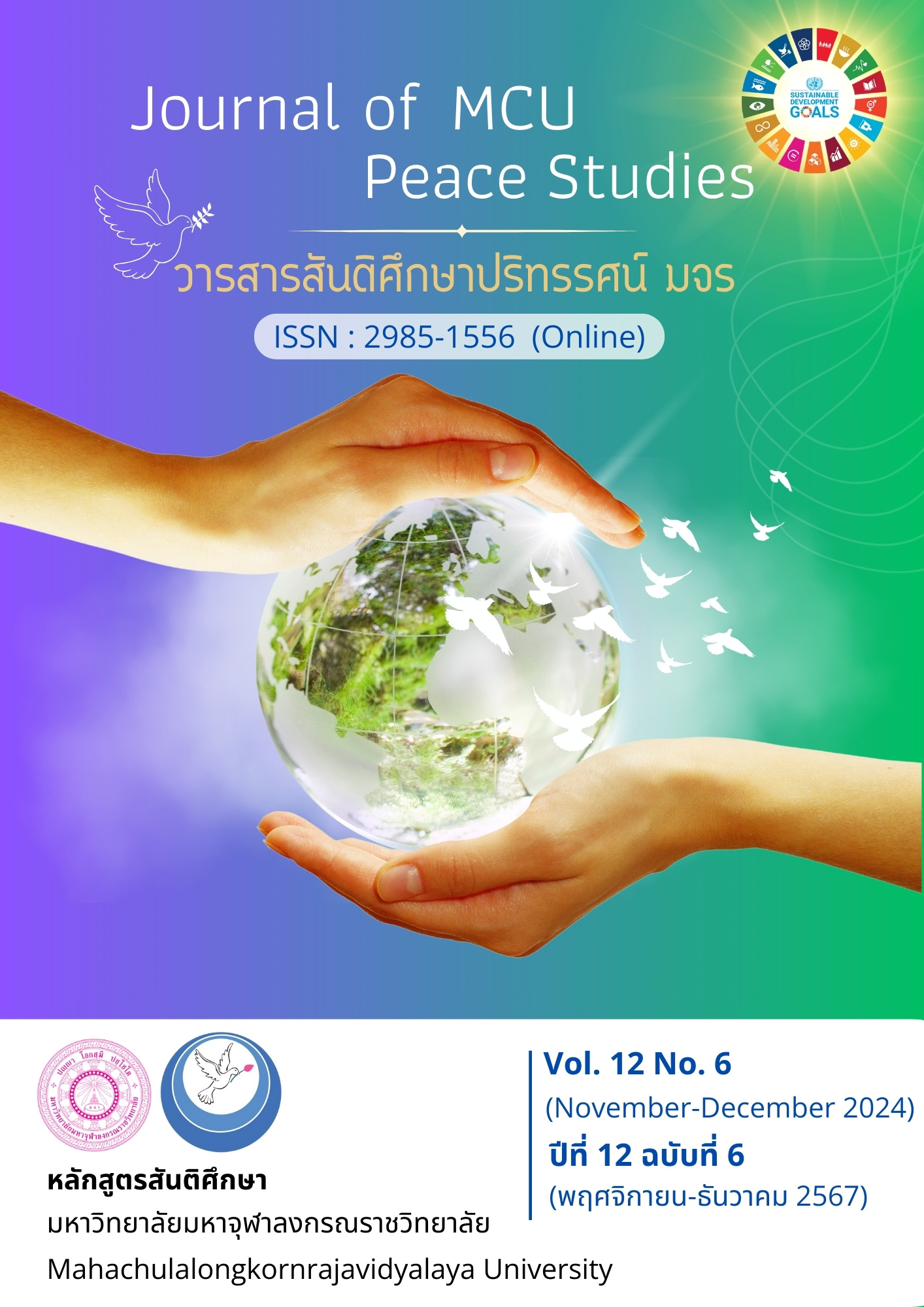The Impact of Visitor Satisfaction on Soundscape Design in Buddhist Temples – A Case Study of the Square around Taiping Xingguo Temple Pagoda
Main Article Content
บทคัดย่อ
This study investigates how visitor satisfaction affects soundscape design and practice in Buddhist temples, with a focus on the square of Taiping Xingguo Temple as a case. This study uses a mixed method to collect and analyze soundscape data, categorizing the soundscape into natural sound, Buddhist sound, human sound, and noise. The objectives of this study are delineated as follows: 1. To record and analyze the sound sources surrounding Taiping Xingguo Temple Pagoda. 2. To evaluate the influence of soundscape elements on visitor satisfaction at Taiping Xingguo Temple Pagoda. 3. To conceptualize a soundscape design for Taiping Xingguo Temple Pagoda that may serve as a model for other temples.
The results of this study reveal that: 1. The soundscape elements consist of four types and most respondents find the traffic noise to be excessively loud. The soundscape of Taiping Xingguo Temple ought to facilitate meditation and relaxation, convey Buddhist teachings and culture, enhance faith and identity, and augment the soundscape’s richness. 2. The elements of the soundscape significantly impact visitor satisfaction. Sounds emanating from Buddhist rituals and the natural environment exert the most substantial positive effect, whereas auditory disturbances negatively affect satisfaction to a considerable degree. This research advocates for augmenting the presence of Buddhist and natural sounds, coupled with the attenuation of noise, to enhance visitors’ perceptions. 3. The design of the soundscape should be strategically focused on reinforcing the temple’s spiritual ambiance. This entails maintaining and honoring its historical and cultural integrity, accentuating its Buddhist essence, establishing balance and cohesion among the various sound sources, and customizing the soundscape’s intensity and rhythm to the spatial functions and the exigencies of the tourists.
Article Details

อนุญาตภายใต้เงื่อนไข Creative Commons Attribution-NonCommercial-NoDerivatives 4.0 International License.
ทัศนะและความคิดเห็นที่ปรากฏในบทความในวารสาร ถือเป็นความรับผิดชอบของผู้เขียนบทความนั้น และไม่ถือเป็นทัศนะและความรับผิดชอบของกองบรรณาธิการ ยินยอมว่าบทความเป็นลิขสิทธิ์ของวารสาร
เอกสารอ้างอิง
Chinese Buddhist Culture Research Institute. (1999). The Diamond Sutra: Chapter One - The Practice of Non-Abiding. Beijing: Religious Culture Press.
Chinese Buddhist Culture Research Institute. (2016). The Thirteen Sutras of the Six Realms by Wang Xiangying. Beijing: Dongfang Publishing House.
Du, Y., & Kang, J. (2019). Soundscape Evaluation in Maijishan Grottoes: A World Cultural Heritage Site. Building and Environment, 147, 1-12.
ISO. (2014). Acoustics-Soundscape Part 1: Definition and Conceptual Framework. Retrieved September 4, 2014, from https://www.iso.org/standard/52161.htmllturePress
Li, G. (2001). Soundscape: A New Category of Sound Research. Chinese Musicology, 15(4), 5-16.
Liu, A. et al. (2017). Soundscape and Its Influence on Tourist Satisfaction. The Service Industries Journal, 37(15-16), 905-922.
Luo, Y., Kang, J., & Zhang, M. (2014). Soundscape Evaluation in a World Cultural Heritage Site: A Case Study of the Qingcheng Mountain Scenic Area. Building and Environment, 80, 18-28.
Qiu, M., Wang, F., Sha, R., & Hou, G. L. (2013). Tourists’ Perception and Satisfaction with Soundscape Attributes of Tourist Attractions: A Case Study of Nanjing Fuzimiao-Qinhuai Scenic Belt. Journal of Tourism, 1, 54-61.
Schafer, R. M. (1993). The Soundscape: Our Sonic Environment and the Tuning of the World. Rochester, VT: Destiny Books.
Tian, F. (2017). Design and Practice of Taiping Xingguo Temple Pagoda Restoration in Yuncheng City, Shanxi Province, China. Heritage World, 6, 37-40.
Zhang, D., Kong, C., Zhang, M., & Kang, J. (2022). Religious Belief-Related Factors Enhance the Impact of Soundscapes in Han Chinese Buddhist Temples on Mental Health. Frontiers in Psychology, 12, 1-16.
Zhang, D., Xiang, Y., & Tao, X. (2017). Research on the Soundscape of Tibetan Buddhist Monasteries in the Liaoning Area. Architectural Science, 33(8), 68-73.
Zhang, D., Zhang, M., Liu, D., & Kang, J. (2018). Sounds and Sound Preferences in Han Buddhist Temples. Building and Environment, 142, 58-69.


